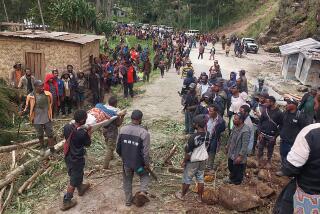Australia Ships Boat People to Distant Refuge
- Share via
JAKARTA, Indonesia — More than 430 refugees who were refused asylum in Australia departed today for Papua New Guinea aboard an Australian troop ship, ending a weeklong international standoff over their fate.
The refugees, who were rescued at sea nine days ago by a Norwegian cargo vessel, were transferred Monday to the troop ship Manoora and set off this morning on the six- to 10-day journey to Papua New Guinea.
The costly naval operation has allowed Australian Prime Minister John Howard to keep his pledge that the boat people, mainly from Afghanistan, would never set foot on Australian soil.
However, the Manoora could be ordered to return to Australia with its human cargo this week if a court in the southeastern city of Melbourne sides with civil rights lawyers and decides that the refugees are entitled to land in Australia and apply for asylum.
Four Indonesians accused of attempting to smuggle the refugees into Australia were arrested Monday as Australian troops transferred the refugees to the Manoora from the Norwegian container ship Tampa.
Howard’s firm stand against allowing the boat people to land on Christmas Island has drawn wide criticism from abroad, but it has also sent his poll numbers soaring at home months before he is expected to face reelection.
The refugees, including some from Sri Lanka and Pakistan, were rescued by the Norwegian ship after their Indonesian ferry began to sink in international waters.
When Indonesia refused to take them back, the Tampa brought them to Christmas Island, a distant outpost of Australia about 220 miles south of the main Indonesian island of Java.
The Australian government sent commandos to seize the boat and refused to let the refugees land, contending that they were “queue jumpers” who had paid smugglers to take them there illegally.
The standoff was finally resolved when New Zealand and the little South Pacific island of Nauru agreed to take the refugees for processing. New Zealand agreed to accept 150 of the asylum seekers as residents.
Under Howard’s plan, the Manoora will take the refugees to Papua New Guinea, where they will be allowed to land. From there, they will be flown to resettlement camps in New Zealand and Nauru.
Nauru is a bleak, impoverished island that once made a living from phosphate mining but has fallen on hard times. It is heavily dependent on Australia, which has agreed to pay for the entire refugee resettlement.
Some of the refugees could eventually end up in Australia if the applications for asylum they will be permitted to make in New Zealand and Nauru are approved.
The face-saving operation is expected to cost Australia at least $10 million--more than it would have cost to keep the refugees on Christmas Island for a year.
The Melbourne court earlier had prohibited Australia from moving the refugees. But after it lifted that injunction, Australian troops ferried the refugees in inflatable speedboats Monday from the Tampa to the more comfortable Manoora.
The Melbourne Age newspaper reported that in a poll taken over the weekend, 77% of respondents approved of Howard’s refusal to accept the refugees. Howard, once the underdog in his campaign for reelection, now has a 10-point lead, his biggest margin in two years, over rival Kim Beazley.
But the bump in the polls has cost Howard internationally. His plan for relocating the refugees has been criticized by U.N. Secretary-General Kofi Annan and U.N. High Commissioner for Human Rights Mary Robinson, among others.
On Monday, Norwegian Foreign Minister Thorbjorn Jagland said the Australians “have ducked the demands of humanitarian law.”
“That is very unfortunate and can have serious consequences if this bad example is followed by other countries so people on the run have nowhere to go,” he told Norwegian state radio. “If this also means that ships don’t dare pick up people in distress at sea, the situation would be extremely serious.”
More to Read
Sign up for Essential California
The most important California stories and recommendations in your inbox every morning.
You may occasionally receive promotional content from the Los Angeles Times.













